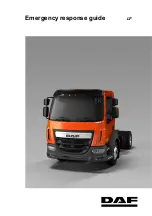
124
locks the door. In this position the pawl is fixed by latch 13 and catch 14. Simultane-
ously, upper guide prong 9 of the lock enters the slot in the striker and protects the
door against sagging.
Fig. 99. Door Lock:
1 – control body; 2 – control spring; 3 – control bracket; 4 – roller; 5 – lock dog; 6 –
door outside handle; 7 – button; 8 – striker slide block; 9 – guide prong; 10 – bolt; 11 –
striker; 12 – pawl; 13 – latch; 14 – latch catch; 15 – spring; 16 – pawl pin; 17 – latch pin;
18 – control tie rod pin; 19 –control tie rod; 20 – control ratchet; 21 – control pin
The door lock drive handles should be positioned horizontally and directed for-
ward.
The door locks can be blocked to prevent its opening from the outside by turning
the lock drive inner handle down. When the lock is blocked, lock dog 5 stops the
latch, holding it engaged with the catch. Besides that, the l.h. door lock can be blocked
from the outside by the key.
To open the door lock, turn the lock drive handle upwards or press the button on
the outside handle. In so doing the latch releases the catch and the pawl returns into
its initial position under the action of spring 15. The door striker is fastened on the
lock post with a screw and two bolts, which allow to adjust it in height and depth.
When adjusting, check that the lock prong 9 enters the slot in striker 11 correctly.
If the striker has been adjusted correctly in height, the door should not lift or lower
down. Adjusting it in depth allows to achieve tight fitting of the striker lower projection
to pawl 12 and at the same time to avoid excessive efforts, when closing the door.
Adjust in depth, meaning for minimum deformation of the door aperture packing
parts, which provides the tight fitting and no rattling when the truck travels. If the door
closes with difficulty, move out the striker, or if the door rattles, move it inside the cab.
When the truck travels, the doors should be closed tight.





































